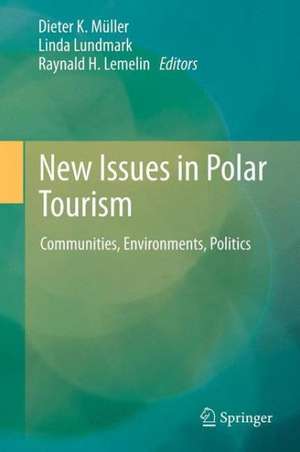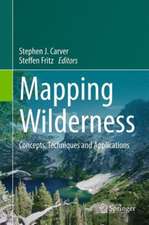New Issues in Polar Tourism: Communities, Environments, Politics
Editat de Dieter K. Müller, Linda Lundmark, Raynald H. Lemelinen Limba Engleză Hardback – 17 dec 2012
| Toate formatele și edițiile | Preț | Express |
|---|---|---|
| Paperback (1) | 637.59 lei 6-8 săpt. | |
| SPRINGER NETHERLANDS – 29 ian 2015 | 637.59 lei 6-8 săpt. | |
| Hardback (1) | 647.40 lei 6-8 săpt. | |
| SPRINGER NETHERLANDS – 17 dec 2012 | 647.40 lei 6-8 săpt. |
Preț: 647.40 lei
Preț vechi: 761.65 lei
-15% Nou
Puncte Express: 971
Preț estimativ în valută:
123.88€ • 129.34$ • 102.53£
123.88€ • 129.34$ • 102.53£
Carte tipărită la comandă
Livrare economică 05-19 aprilie
Preluare comenzi: 021 569.72.76
Specificații
ISBN-13: 9789400758834
ISBN-10: 9400758839
Pagini: 240
Ilustrații: XIV, 226 p.
Dimensiuni: 155 x 235 x 19 mm
Greutate: 0.61 kg
Ediția:2013
Editura: SPRINGER NETHERLANDS
Colecția Springer
Locul publicării:Dordrecht, Netherlands
ISBN-10: 9400758839
Pagini: 240
Ilustrații: XIV, 226 p.
Dimensiuni: 155 x 235 x 19 mm
Greutate: 0.61 kg
Ediția:2013
Editura: SPRINGER NETHERLANDS
Colecția Springer
Locul publicării:Dordrecht, Netherlands
Public țintă
ResearchCuprins
1. Introduction: New Issues in Polar Tourism.- 2. Looking Back, Venturing Forward: Challenges For Academia, Community and Industry in Polar Tourism Research.- 3. What is Arctic Tourism, and Who Should Define It? .- 4. Narrative Frameworks of Consideration: Horizontal and Vertical Approaches to Conceptualising the Sub-Antarctic.- 5. Reaching Consensus on Antarctic Tourism Regulation.- 6. The Effectiveness of Environmental Impact Assessments on Visitor Activity in the Ross Sea Region of Antarctica.- 7. German Tourism Activities in the Antarctic Area – A Governmental Perspective.- 8. The Wild North – Network Cooperation for Sustainable Tourism in a Fragile Marine Environment in the Arctic Region.- 9. Tourism Resolving Crisis? Exploring Tourism Development in Iceland in the Wake of Economic Recession.- 10. A (Ski) Trip into the Future - Climate Change and Winter Tourism in Polar Sweden in 2040.- 11. Conflicting Discourses in Tourism Development - A Case of Kilpisjärvi Village, Finnish Lapland.- 12. Will 'Free Entry into the Forest' Remain? Argumentation Analysis of Finnish and Swedish Discussions on Everyman's Rights.- 13. National Parks for Tourism Development in Sub-Arctic Areas – Curse or Blessing? The Case of a Proposed National Park in Northern Sweden.- 14. Indigenous People: Discussing the Forgotten Dimension of Dark Tourism and Battlefield Tourism.- 15. New Issues in Polar Tourism: Conclusion.- Index.
Textul de pe ultima copertă
New Issues in Polar Tourism traces and analyzes a decade of growing interest in the polar regions, and the consequent challenges and opportunities of increasing tourist traffic in formerly remote and seldom-visited places. The book arises from the recently-formed International Polar Tourism Research Network (IPTRN), and documents the outcomes of its 2010 conference, held at Sweden’s Abisko Scientific Research Station.
Opening with a review of the early history of polar tourism, the book discusses reasons for the rise in traffic to more than 12 million visitors to the Arctic (2006) and some 40,000 to the Antarctic (2009-10). These causes include “last chance” tourism inspired by increased media coverage of climate change, easier access to remote areas due to the shortening ice-season and the pursuit of tourism by destination areas seeking economic and employment opportunities.
In subsequent chapters, the editors and contributors introduce environmental politics andimpacts, and draw attention to physical impacts of tourism, to conceptual ideas of polar wilderness and to practical political action. The third section of the book addresses communities and tourism in polar areas, discussing how businesses operate in polar environment with respect to climate change and how the tourism industry can both advance and threaten efforts to sustain delicate environments and communities.
Coverage includes case studies examining indigenous peoples and tourism, a chapter speculating on the nature of winter tourism in n Sweden in the year 2040 and a concluding chapter which draws together the findings of the book.
Opening with a review of the early history of polar tourism, the book discusses reasons for the rise in traffic to more than 12 million visitors to the Arctic (2006) and some 40,000 to the Antarctic (2009-10). These causes include “last chance” tourism inspired by increased media coverage of climate change, easier access to remote areas due to the shortening ice-season and the pursuit of tourism by destination areas seeking economic and employment opportunities.
In subsequent chapters, the editors and contributors introduce environmental politics andimpacts, and draw attention to physical impacts of tourism, to conceptual ideas of polar wilderness and to practical political action. The third section of the book addresses communities and tourism in polar areas, discussing how businesses operate in polar environment with respect to climate change and how the tourism industry can both advance and threaten efforts to sustain delicate environments and communities.
Coverage includes case studies examining indigenous peoples and tourism, a chapter speculating on the nature of winter tourism in n Sweden in the year 2040 and a concluding chapter which draws together the findings of the book.
Caracteristici
Focuses attention on land-based tourism in the Arctic and Antarctic regions Combines theoretical contributions with new empirical data from hitherto seldom-covered sources and destinations Spans disciplines to discuss conservation, tourism, indigenous populations, resource extracting activities, science and international cooperation

























